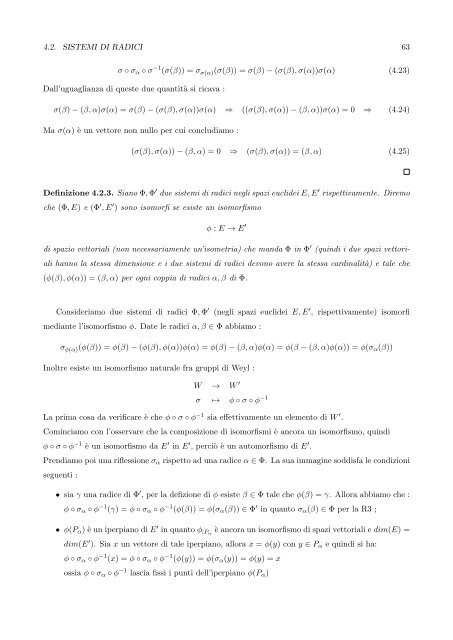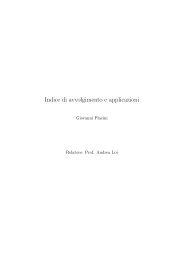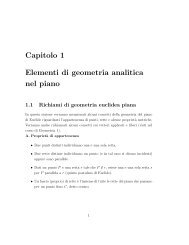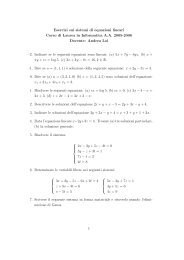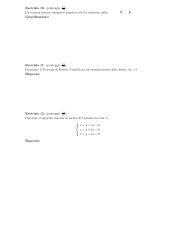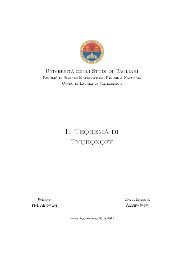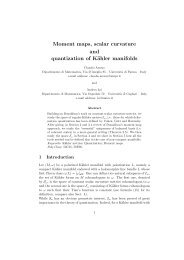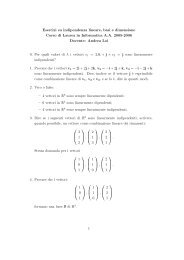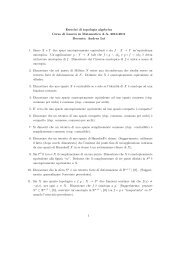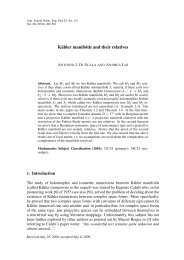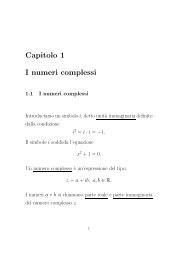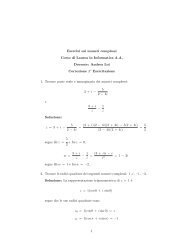Algebre di Lie semisemplici, sistemi di radici e loro classificazione
Algebre di Lie semisemplici, sistemi di radici e loro classificazione
Algebre di Lie semisemplici, sistemi di radici e loro classificazione
Create successful ePaper yourself
Turn your PDF publications into a flip-book with our unique Google optimized e-Paper software.
4.2. SISTEMI DI RADICI 63<br />
σ ◦ σα ◦ σ −1 (σ(β)) = σ σ(α)(σ(β)) = σ(β) − (σ(β), σ(α))σ(α) (4.23)<br />
Dall’uguaglianza <strong>di</strong> queste due quantità si ricava :<br />
σ(β) − (β, α)σ(α) = σ(β) − (σ(β), σ(α))σ(α) ⇒ ((σ(β), σ(α)) − (β, α))σ(α) = 0 ⇒ (4.24)<br />
Ma σ(α) è un vettore non nullo per cui conclu<strong>di</strong>amo :<br />
(σ(β), σ(α)) − (β, α) = 0 ⇒ (σ(β), σ(α)) = (β, α) (4.25)<br />
Definizione 4.2.3. Siano Φ, Φ ′ due <strong>sistemi</strong> <strong>di</strong> ra<strong>di</strong>ci negli spazi euclidei E, E ′ rispettivamente. Diremo<br />
che (Φ, E) e (Φ ′ , E ′ ) sono isomorfi se esiste un isomorfismo<br />
φ : E → E ′<br />
<strong>di</strong> spazio vettoriali (non necessariamente un’isometria) che manda Φ in Φ ′ (quin<strong>di</strong> i due spazi vettori-<br />
ali hanno la stessa <strong>di</strong>mensione e i due <strong>sistemi</strong> <strong>di</strong> ra<strong>di</strong>ci devono avere la stessa car<strong>di</strong>nalità) e tale che<br />
(φ(β), φ(α)) = (β, α) per ogni coppia <strong>di</strong> ra<strong>di</strong>ci α, β <strong>di</strong> Φ.<br />
Consideriamo due <strong>sistemi</strong> <strong>di</strong> ra<strong>di</strong>ci Φ, Φ ′ (negli spazi euclidei E, E ′ , rispettivamente) isomorfi<br />
me<strong>di</strong>ante l’isomorfismo φ. Date le ra<strong>di</strong>ci α, β ∈ Φ abbiamo :<br />
σ φ(α)(φ(β)) = φ(β) − (φ(β), φ(α))φ(α) = φ(β) − (β, α)φ(α) = φ(β − (β, α)φ(α)) = φ(σα(β))<br />
Inoltre esiste un isomorfismo naturale fra gruppi <strong>di</strong> Weyl :<br />
W → W ′<br />
σ ↦→ φ ◦ σ ◦ φ −1<br />
La prima cosa da verificare è che φ ◦ σ ◦ φ −1 sia effettivamente un elemento <strong>di</strong> W ′ .<br />
Cominciamo con l’osservare che la composizione <strong>di</strong> isomorfismi è ancora un isomorfismo, quin<strong>di</strong><br />
φ ◦ σ ◦ φ −1 è un isomorfismo da E ′ in E ′ , perciò è un automorfismo <strong>di</strong> E ′ .<br />
Pren<strong>di</strong>amo poi una riflessione σα rispetto ad una ra<strong>di</strong>ce α ∈ Φ. La sua immagine sod<strong>di</strong>sfa le con<strong>di</strong>zioni<br />
seguenti :<br />
• sia γ una ra<strong>di</strong>ce <strong>di</strong> Φ ′ , per la defizione <strong>di</strong> φ esiste β ∈ Φ tale che φ(β) = γ. Allora abbiamo che :<br />
φ ◦ σα ◦ φ −1 (γ) = φ ◦ σα ◦ φ −1 (φ(β)) = φ(σα(β)) ∈ Φ ′ in quanto σα(β) ∈ Φ per la R3 ;<br />
• φ(Pα) è un iperpiano <strong>di</strong> E ′ in quanto φ |Pα è ancora un isomorfismo <strong>di</strong> spazi vettoriali e <strong>di</strong>m(E) =<br />
<strong>di</strong>m(E ′ ). Sia x un vettore <strong>di</strong> tale iperpiano, allora x = φ(y) con y ∈ Pα e quin<strong>di</strong> si ha:<br />
φ ◦ σα ◦ φ −1 (x) = φ ◦ σα ◦ φ −1 (φ(y)) = φ(σα(y)) = φ(y) = x<br />
ossia φ ◦ σα ◦ φ −1 lascia fissi i punti dell’iperpiano φ(Pα)


